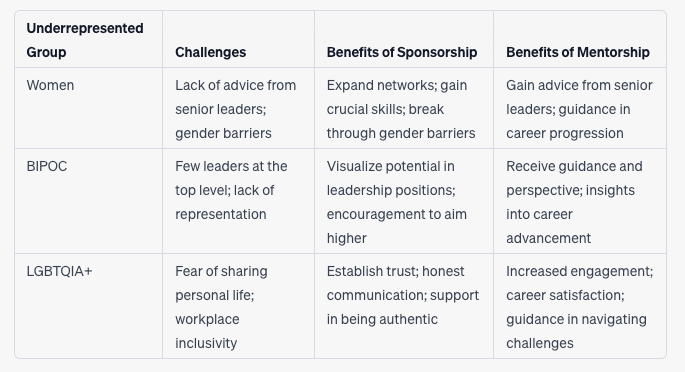People have long wondered — sponsorship vs mentorship, which is right for my organization or my career? But both have been used to give people a critical boost early in their careers. The two practices have a lot in common, but they do have different definitions and functions. While both can have a big impact in their own way, they can be even more effective when they are used together, especially for underrepresented groups.
What is Mentorship?
Mentoring is a learning relationship in which a senior person advises and nurtures a less experienced person toward long-term career development. Mentors act as sounding boards, help mentees build skills, and offer advice in making savvy decisions within a context of trust and confidentiality.
Mentors “shine as you start to define your dream. They can see and put into words for you what you may not see about yourself or be able to articulate. They can help you determine your strengths: what you do exceptionally well and what sets you apart,” says Sylvia Ann Hewlett, President and CEO of the Center for Talent Innovation, in an interview with Forbes.

What is Sponsorship?
Sponsorship goes beyond advising to action. A sponsor takes steps to help the less experienced person in concrete ways such as making crucial introductions and actively promoting or defending them.
According to Rosalind Chow, associate professor of organizational behavior and theory at Carnegie Mellon University, sponsorship is often defined as “spending one’s social capital or using one’s influence to advocate for a protégé.” While mentorship generally just involves the mentor and mentee, sponsorship is a “three-way relationship between sponsors, protégés, and an audience,” Chow says.

What’s the Difference between Sponsorship and Mentorship
Any debate that pits sponsorship vs. mentorship misses the point; both are important in moving careers forward. Less experienced employees greatly benefit from the emotional support and seasoned perspective that they can get from a trusted mentor. And sponsorship can open up critical possibilities that the protégé might otherwise miss.
Some sponsorships can start out as mentoring relationships. This represents an opportunity for the two parties to get to know each other better, for trust to develop, and for a potential sponsor to assess the mentee’s potential. Sometimes a mentor can introduce their mentee to a potential sponsor within their organization. Other times, mentoring and sponsoring relationships are completely separate.
But creating a strong mentoring culture within an organization often provides a suitable foundation for both mentoring and sponsorship. The more people are aware of the principles of mentoring and sponsoring, the less likely they are to compare mentoring vs sponsorship and the more likely people are to step into those roles and responsibilities. This helps to engage, advance and develop the people of your organization more productively.
What is coaching vs mentorship vs sponsorship?
While mentorship and sponsorship focus on the long-term growth and support of the employee, coaching targets specific goals. For example, you might engage a media coach to help a new executive learn how to participate in interviews, panel discussions and other media opportunities.
Unlike mentorship and sponsorship, coaching is often time-limited and intensive. To succeed, coaching initiatives must have clear goals and objectives, buy-in from the executive team and a means of tracking success.
Like mentorships and sponsorship, coaching is far from an exclusive proposition. You may choose to develop coaching programs alongside mentorship and sponsorship programs in order to achieve a suite of short- and long-term objectives.
A coach teaches a specific skill or provides support in achieving a goal. Typically, they come from outside the organization and work with the employee for a limited period of time.
A mentor provides long-term support with a wider focus. For example, leadership development mentoring connects high-potential employees with top performers and managers. These mentors can offer support across a variety of areas.
A sponsor uses their experience, knowledge and social capital to help an employee advance in their career. Again, sponsors may start out as mentors and grow from there.

Can a mentor also be a sponsor?
A mentor can become a sponsor by taking a more active role in an employee’s career. Once they do so, the employee becomes a protege and benefits from more direct intervention. Typically, this happens after the mentor and mentee have worked together for at least a few months and developed a rapport. Because the sponsor will be putting their reputation on the line, it’s essential to build trust first.
Once the relationship has evolved, it’s no longer strictly a mentorship dynamic. The sponsor may continue to provide guidance and moral support, but the focus has changed. As an example, picture an employee who is applying for a more senior role within the organization. A mentor will support the employee by offering insight into the requirements of the job and the culture of the organization. A sponsor may provide that same support, but they will also advocate on behalf of the employee with senior leadership.
Tips for Building a Successful Sponsorship Program
Sponsors can open doors for their proteges in a variety of ways. They might connect them with opportunities in the organization, advocate directly for their advancement with stakeholders or increase their visibility by sharing their wins with a wider audience.
In taking these steps, sponsors put their reputations on the line in a way that mentors do not. Therefore, it’s especially important to design sponsorship programs with care in order to ensure the best results for participants and the company.
Get executive buy-in
In order to succeed, sponsorship programs must have support from leadership. Ideally, these initiatives should occupy a space in a broader culture of learning. The organization should weave sponsorship and mentorship into its core values as well as individual goals and KPIs.
Set goals and metrics
What drives your sponsorship program? Identify your goals and set metrics to define success. Set realistic targets and KPIs and make sure your program objectives are specific and time-bound. A little precision during the planning process will yield more measurable, actionable results down the line.
Fight unconscious bias
“If you constantly look for role models who look like you, then there won’t be any firsts,” said former Secretary of State Condoleezza Rice at The Women’s Conference 2008. “Sally Ride would not have been the first woman astronaut had she been looking for a woman to follow.”
Formal sponsorship programs are a way to mitigate this bias by encouraging leaders to work with employees from different backgrounds. However, companies need to take steps to measure diversity in these initiatives and to educate participants about organizational goals.
Build trust
Sponsorship initiatives thrive or fail on the strength of the relationships involved. Giving sponsors and proteges a chance to participate in the matching process can go a long way. It’s also important to allow sponsor pairs to develop a rapport before moving forward. Sponsors will feel more comfortable advocating for their proteges once they’ve built trust.
The Importance of Mentorship and Sponsorship for Underrepresented Employees
If still deciding in sponsorship vs mentorship, know that both are powerful tools for cultivating diversity and equity for underrepresented groups, including women, black, indigenous and people of color (BIPOC), as well as LGBTQIA employees. These groups are sorely underrepresented in senior leadership positions, and often, they don’t receive the mentoring or sponsorship opportunities that can be so valuable for positive engagement and rising in the ranks.

Women
According to aLeanin.org survey, women are 24 percent less likely than men to get advice from senior leaders. Meanwhile, 62 percent of women of color feel that they are being held back by not having an influential mentor. Sponsorship and mentorship help women expand their networks, gain crucial skills andbreak through gender barriers.
BIPOC
As of the end of 2020,almost90% ofFortune500 CEOs were white males. With few BIPOC leaders at the top level, it can be a challenge for aspiring executives of color to visualize themselves in these positions. Engaging with a mentor or sponsor who offers encouragement and paints a picture of possibility can be invaluable in helping a mentee aim higher.
LGBTQIA+
According toMcKinsey research, LGBTQIA women are more than twice as likely as straight women to feel as though they cannot share their life outside of work with colleagues. On the other side, LGBTQIA women who are out at work tend to be happier with their careers and workplace than those who are closeted. Mentorships can offer a relationship of trust in which LGBTQIA employees can be honest about who they are, feel supported and engage more at work.
Why Do You Need Both Mentorship and Sponsorship?
Because sponsorship may evolve out of mentorship, you may think that your organization can do with just one type of initiative. However, it’s worth continuing to invest in mentorship for its own merits.
Mentorship offers unique possibilities for two-way learning and support. Sponsorship, with its laser focus on career promotion, might not offer as fertile ground for learning new skills or developing peer relationships. However, it does offer unique possibilities for connecting high-potential employees with opportunities.
Traditionally, mentor/sponsor relationships have been formed by chance or by self-selection in which sponsors often choose people who are like them, excluding many others who are equally worthy of sponsorship.
Intentional sponsorship or mentorship programs help ensure that deserving employees get the opportunity to learn from senior leaders and receive recognition and opportunities—no matter their background or identity.
How Can Organizations Encourage Sponsorship?
Establishing amentorship program is critical for organizations that want to encourage equitable sponsorship, formal or informal. Mentorships can develop into sponsorship as the more experienced person helps identify specific opportunities and actively uses their influence to help the protégé take advantage.
Some organizations also createformal sponsorship programs alongside their mentoring programs. Companies such as American Express, AT&T, Deloitte, and others have also createdformal paths to sponsorship.
Whether sponsorship programs are formal or informal, companies can set themselves up for success by creating intentional, fair, and effective ways of connecting senior employees with their less experienced counterparts. These connections — more than debating sponsorship vs mentorship — are key for helping employees reach their potential and creating a thriving organization.
Enabling Formal Sponsorship Programs with Mentoring Software
Whether you’re just getting started with employee sponsorship or looking for ways to measure the success of existing initiatives, mentoring software can help. Easily track essential metrics that will demonstrate ROI to leadership while reducing your administrative burden and offering easy-to-scale, personalized experiences to participants.
Mentoring software can help you do everything from build more effective matches to support employees at every step of the sponsorship journey.
Bottom Line
Reframing your focus to embrace both sponsorship and mentorship initiatives offers big payoffs for organizations and employees alike. Strengthen your management pipeline, create a more inclusive culture and build your employer brand. Sponsorship and mentorship help your company grow by investing in your most important asset: your workforce.